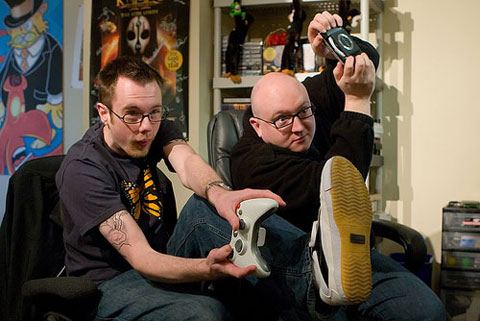
GABE AND TYCHO Instead of apologizing to fans offended by their rape joke, Penny Arcade creators Mike Krahulik (left) and Jerry Holkins mocked the outrage with a Dickwolves T-shirt. |
One September evening in 2005, I sat in a packed MIT lecture hall and watched as Mike Krahulik drew the Greater Internet Fuckwad Theory on a blackboard. The Theory was one of the things for which Krahulik and his partner, humorist Jerry Holkins, first became famous, back in 2004 — just around the same time that their Web comic, Penny Arcade, was blossoming into a community and a convention and a movement.
On the blackboard, Krahulik drew a smiling, unassuming man, and labeled him "Normal Person." Then he drew a plus sign next to the man's face. The audience was already tittering with excited recognition. Finally he finished the full equation: Normal Person + Audience + Anonymity = Total Fuckwad. The MIT audience burst into laughter and applause, and I did too. It was brilliant shorthand for describing the behavior of people on the Internet, and an example of Penny Arcade's knack for getting at the heart of video-gaming culture's unsavory tendencies.
None of us knew that Krahulik and Holkins had just described their future trajectory.
Penny Arcade began in 1998 as a simple Web comic about video games and gamers, drawn by Krahulik and written by Holkins, and starring their alter-egos, Gabe and Tycho. The comic's forums quickly grew into one of the most popular spaces for gamers online. Part of the reason was Krahulik and Holkins' accessibility. Tycho and Gabe, as their readers knew them, weren't game developers or game journalists or the kind of people who held press conferences. They were just fans, like everyone else. And even as Penny Arcade grew in popularity and influence, they held on to that humble identity as just two guys telling jokes.
As Holkins told the audience that night at MIT, "We are in the gaming industry the same way a barnacle is in the shipping business."
By then, though, that wasn't really true. Krahulik and Holkins's opinions were plastered all over gaming blogs and news feeds. They could make or break industry sales by drawing a picture of a video-game character in their comic. And the comic was already the least of their endeavors.
In 2004, they'd held the first-ever Penny Arcade Expo in Seattle and drew about 3300 people. By 2010, they had PAX events on both coasts — with more than 67,000 attendees in Seattle and more than 52,000 at PAX East in Boston. When PAX East returns to Boston next week, March 11 through 13, it's upgrading to a bigger venue: from the sprawling Hynes Convention Center to the even more enormous Boston Convention and Exposition Center on the waterfront. They've already sold out of three-day passes.
Last year, when Krahulik and Holkins made the Time 100 list of the world's most influential people, they had 3.5 million readers per day. The Time blurb also mentioned Child's Play, a charity founded by the duo to give video games to sick children. In 2010, Child's Play raised more than $2 million, and Penny Arcade began PA TV, a documentary Web series about Krahulik, Holkins, and their underlings at the Penny Arcade offices. The show covers everything from the two spit-balling ideas for the thrice-weekly comic that started it all, to the offices organizing PAX Prime, PAX East, and Child's Play. In the Time 100 blurb, Holkins said, "We specifically don't try to figure out what we are." "Except rad," added Krahulik.